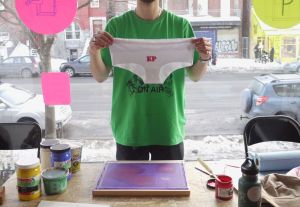Image Source: John Twells
Indie has run its course. Like Autumn in Montreal, it disappeared before we could take the first few sips of our pumpkin-infused coffees and savour the sun’s mellow heat on a crisp October morning. Before we know it, we are consumed by darker days, deadlines, and the chaos that is our public transit system after two inches of snow. In a similar fashion, with the departure of indie veterans like The Smiths and Oasis, indie music has had its prime and is all but a faint memory. But is this entirely true? The rise of “Bedroom Pop” tells us otherwise. Artists like Clairo, Yellow Days, and Cuco have taken the Internet by storm, or rather, soothed the Internet with their warm synths and dreamy vocals. In other words, Bedroom Pop may be indie’s defibrillator and is set to revive it.
The Rise and Fall of Indie
Before we explore the ins and outs of Bedroom Pop as a musical subgenre, we need to turn the clock way past the bucket hats and halter-neck tops that coined the 90s indie scene and back to floppy haircuts, thrifted leather jackets, and the Buzzcocks. The rise of indie officially began with the Manchester-based quartet’s April 1977 release of Spiral Scratch - a four-track punk EP. It was rock’s first independently-funded and distributed disc and epitomized what it was to be indie: independent and in complete control over image and production. By the end of 1978, the UK alone boasted of hundreds of self-starting imprints, with labels like Rough Trade, Factory, and Mude. By the mid-80s, the DIY ethic resonated globally, with bands like The Smiths touring worldwide. Although Johnny Marr’s African-inspired guitar riffs and Morrissey’s wailing vocals captured fans all around the world, it was only the beginning of the indie phenomena. Indie reached its full potential in the 1990s, officially claiming its crown with small and low-budget record labels such as Warp and Domino. Artists like Elliot Smith, Beck and Sonic Youth were quintessential to this movement.
Yet, the off-kilter lyrics and acoustic sounds of 90s indie came to a halt once the 2000s hit. The new millennium introduced stars like the Spice Girls and Puff Daddy, who overshadowed any fame that indie artists had once amassed. And as soon as the Mississippi teenager and Mickey Mouse Club veteran Britney Spears signed Jive Records, the world would never be the same. That year, the Backstreet Boys released two LPs that would eventually sell 28 million copies and Spears would sell more than 150 million albums over the next decade. In stark contrast, Sleater-Kinney’s breakthrough LP sold just over 140,000 copies across two decades. As Robert Fink, a music historian at UCLA, we were at the foot of ‘Britney Mountain’. Whatever indie symbolized, and whatever intangibles it was going to deliver, it was not going to be about money or sales. Whatever intangibles indie was going to deliver, whatever it symbolized, it was not really going to be about money and sales. Indie music had officially retired.
21st-Century Indie
Defining music genres is always a tricky task. The parameters of a genre are almost always larger than we think, usually overlapping with many others. It can be especially challenging to define these parameters in the age of the Internet, with more and more artists sharing their music and taking inspiration from each other. From psychedelic jazz to jazz punk, there seem to be no limits to what genres are possible. But when we discuss indie, there seems to be a general misconception about what it is and sounds like. We know how it started and its established connection to independence, but what happens when “indie” bands like the Arctic Monkeys, who came to fame through MySpace, start selling out arenas? With the rise of the internet, indie doesn’t exactly mean what it used to mean. Artists nowadays can produce and distribute their music independently and still reach great fame. Today’s indie has more to do with attitude and energy; it’s about what you’re doing at the moment, rather than where you’re potentially going. It’s about embracing the quirks of every-day life and the small agonies that come along with it. It’s down-to-earth, sincere, and makes light of the awkwardness in human interaction. Rather than those physical features of indie that coined the genre in the 80s, 21st-century indie has much more to do with feelings of uncertainty and finding community in those feelings. So, where does Bedroom Pop come into play?
What is Bedroom Pop?
Bedrooms are much more essential to our well-being and comfort than we may consciously recognize. It’s a place where we feel safe and can truly be ourselves. In a world that is overly complex and, thus, becoming tougher for teens to navigate, a bedroom can serve as a place of solace - free of expectations, judgments and made for you. With indie music often being connected with young people’s perspectives, it does not come as a surprise that the smooth easy-going lo-fi tunes made by teens in their bedrooms are an attempt to create a safe space in an ever-changing world. Such artists have taught themselves how to record and share music within the comfort of their bedrooms - making the entire process personalized and letting artists have complete control over what they make. Those who may not have had access to formal training have been aided by the paint-by-numbers tutorials on YouTube. A great example of the increased accessibility is GirlinRed’s Instagram post reading, “me n my studio,” which shows her sitting on her bed with a laptop and recording equipment. The barriers that might have once made the music industry inaccessible are slowly deteriorating. For the first time ever, we are hearing artists who have learned everything they know with the help of the Internet.
Not only is Bedroom Pop underpinned by the process of producing in a bedroom, but it is also characterized by quirky lyricism, off-kilter sounds, and low-quality production. Clairo, for example, often uses soft longing vocals on top of clinky synths, combined with lyrics about navigating the labyrinth that is youth. Often sounding like it was recorded on a toy piano, Bedroom Pop is as low-production as it is charming.
Carrying on the Legacy of Indie Music?
This leaves us wondering: is Bedroom Pop the new indie of the 2010s? It certainly checks all the boxes, fulfilling the DIY ethos of 80s indie, embodying an “against-the-stream” spirit, with distinctly youth-driven energy. But as Lisa Simpson once said, “anything that’s the something of the something isn’t really the anything of anything.” Bedroom Pop doesn’t necessarily have to be boxed in as one genre to revive indie music as a whole. However, it is safe to say that it is reintroducing some of the independence and control that first defined indie music 30 years ago. No matter what the subgenre will do for indie music, all we can do for now is lean back and enjoy the simplicity and charm that is Bedroom Pop.



